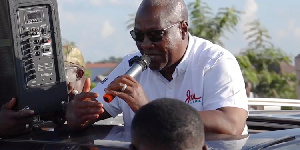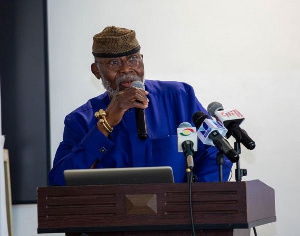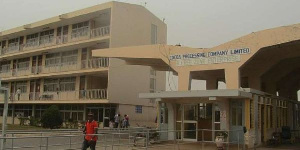Opinions of Tuesday, 2 March 2004
Columnist: Fredua-Kwarteng, Y.
Ranking SSS Certificate Examination Results
Recently the Ghana Education Services published the SSS Certificate Examination Result League, in which secondary schools in Ghana were ranked from first position to last based on the total number of students each school presented in the examination and the number of candidates that passed 6-7 subjects. Other information including the number of passes in 5, 4, 3, 2, and 1 subject for each school, along with fails, absences, results withheld, and results cancelled was also displayed in the SSS certificate Examination Results League. The ranking has become the subject of an intense public discussion among Ghanaians inside and outside of Ghana. While some people jubilated over the performance of their former schools, others bowed down their heads in despair. Some people even stated categorically that their former schools were better than others simply because they came to the top positions in the ranking. Some friends of mine shrugged off the ranking calling it an unnecessary publication designed to undermine public confidence in some schools in Ghana. My wife asked to see the League because she did not believe that her alma mater Achimota Secondary School finished 14th.
However, a vast majority of the people involved in the discussion regard the ranking as a positive step toward the promotion of competition among secondary schools in Ghana. To these people, Ghana secondary schools require a heavy dose of competition in order to raise standards of teaching, learning, and examination performance. Because some conservative economists advocate competition as an effective means to improve business performance and profitability, these Ghanaians also see a positive correlation between competition and standards of teaching and learning and examination performance. However, this is a wrong application of the orthodox ideology of competition to the administration of public educational organizations on three main grounds.
First, public secondary schools are social, moral and academic organizations charged with the function of developing social responsibilities in young people, train them in sound moral precepts, and equip them with appropriate skills, knowledge and abilities for the purposes of future employment, professional education or post-secondary studies. Thus, one cannot use a quantitative tool such as examination results to assess their performance. Second, public secondary schools depend on the state for about 80% of their funding. For this reason, they do not have any bottom line to improve, though they must operate within the constraints of their budgetary allocation. Third, public schools are located in an area with needs, not where they can obtain the highest profit as business organizations do. Therefore, there are natural disparities in the pool of resources that a school can access. Schools located in economically depressed areas have little access to qualified teachers relative to those established in economically prosperous areas. This factor does not apply to Catholic schools that have access to professional teachers, along with both private and public funding.
Some people are also suggesting that the SSS Certificate examination results should be used as an objective criterion for the allocation of resources of money, personnel, and other facilities to secondary schools. If so, then schools that came to the bottom of the ranking should receive the greatest portion of our educational cedis allocation. Nevertheless, if schools that came to the top were to use their examination performance as a rationale for demanding more educational resources then schools that did badly would soon be wiped out. In this scenario, whose interest would be served? Professionally, I have characterized the location of education resources on the basis of examination results as analogous to measuring temperature with a teaspoon. I think that if the government wants to find objective criteria for distributing our educational resources, it must conduct a needs assessment of each school according to predetermined standards. Ghana Ministry of Education must develop such standards after consultation with stakeholders of the education enterprise such as headmasters, teachers, parents, students, and the general public. The needs assessment is comprehensive assessment carried by a team of seasoned educators. They would visit each school, examine its facilities (classrooms, furniture, science, laboratories, etc.), observe instructional and assessment practices, teacher-student class interactions, school curriculum, the nature of learning activities, interview students, teachers, and headmasters, and ascertain the academic qualifications and length of experience of the teaching staff.
Now let us look more closely at the published SSS certificate Examination results. A percentage was calculated for each school by expressing the total number of candidates that passed 6-7 subjects as a proportion of the total number of students that the school presented in the examination. As an illustration, Wesley Girls High School presented a total of 396 candidates. Out of that 393 passed 6-7 subjects, and so its percentage of passes expressed as a percent of candidates presented is 99.24 (393/396 x100) and it came first. Opoku Ware?s percentage is 97.87(460/470 x100) and placed second. Holy Child Secondary?s percentage is 97.68; that is, 253/259 x 1000. St. Peters Secondary School scored 97.19% (346/356 x 100) and occupied the third position. Yaa Asantewa with a percentage of 96.66 took the forth place. Asanteman Secondary School was given 47th position (236/323 x 100) and Krobo Girls has the 48th position with 72.83% (126/173 x 100) Nevertheless, this method of making comparison obscures many things. One, we have no information about why some schools presented more candidates than others. For example, Agogo Secondary School presented 633 candidates but Sefwi Bekwai Secondary School presented 38 candidates. Accra Academy had 598 candidates relative to St Stephen Day Secondary Technical with only 40 candidates or Adeiso Secondary School with 64 candidates. However, if examination results are the sole ground for judging a school?s performance, then some secondary schools are more likely to present only their best candidates in such examinations and the incidence of examination malpractices might increase astronomically.
Two, the method of ranking based on the percentages I have demonstrated above obscures the real performance of each school and it is mathematically misleading. For instance, out of the 470 candidates that Opoku Ware presented, 460 passed in the 6-7-subject range. By contrast, Wesley Girls had 396 candidates and achieved 393 passes in that subject range. In terms of the total candidates that passed the examination in 6-7 subjects for that year in Ghana, Opoku Ware Secondary School did better than Wesley Girls. Using the same mathematical reasoning, Accra Academy with 442 passes in the 6-7 subject range outperformed Wesley Girls, Holy Child Secondary School with 253 passes, St. Peters with 346 passes, St. Louis with 302 passes, St James with 192 passes, St. Roses with 223 passes, St. Mary with 215 passes, and so on. In addition, using the same reasoning, Prempeh College performed the best with 646 passes out of 703 candidates.
My mathematical formula of calculating the number of successes or passes in the 6-7 subject range as a percent of the total passes in that examination session in Ghana is logically sound. In fact, we can calculate the proportion of passes in 6,5,4,3,2 or 1 subject as a percent of the total number of passes in that examination session for each school. As I have stressed, this is more useful than calculating the number of passes as a percent of the number of candidates presented in the examination. If this reasoning is erroneous, then look at this scenario. There are two doctors located in different parts of a certain country, who are required to treat patients suffering from the same disease. Doctor A has 4 patients for treatment and the other, doctor B, has 8 patients. In this example, I am assuming that all the patients have the same health histories, belong to the same socio-economic class and gender, and the length of suffering from that disease and its severity are equal. As well, both doctors have the same training and level of experience. Doctor A successfully treated all his patients. And this represents 100% (4/4 x 100) performance rate. However, doctor B succeeded in treating only 5 of his 8 patients and this gives him about 63% (5/8 x 100) performance achievement. Can we say that the doctor with 100% performance rate did better than the one with 63%? Certainly, not! If we calculate the proportion of success rate for each doctor as a percent of the total patients treated, the doctor with 4 patients has about 44% (4/(4+5) x100)} and the other one has approximately 56%(5/(4+5) x100). From the calculations, doctor B performed better than doctor A. Consequently, we have to watch out for such a fallacious comparison using percentages.
Forth, the SSS Certificate Examination Results League does not show which schools are making progress and which are not, in terms of the number of passes in the 6-7 subject range over a period of time say three years. The publication of the number of passes in the 6-7 subject range for each school, along with the number of candidates each presented, for at least three years period, would have shown a trend of progress for some schools. For this would iron out variability in performance that some schools might experience from time to time. That is, some schools may have more passes in the 6-7 subject range in year 1 than year 2 but less in year 3.And in that case, it would be more practical to calculate other statistics such as the averages and variances to make a better judgement about schools that are making real progress in performance at the SSS certificate examination. Thus, the SSS Certificate Examination Results League is not useful for making critical decisions about which schools are making improvement and which ones are not.
Finally, the SSS certificate examination results show that Catholic schools including Holy Child, Opoku Ware, St. Roses, and St. Peters, St. Monica?s and St. Louis performed better than their Non-Catholic counterparts. Does this suggest that Catholic schools are better managed, have access to professionally committed teachers and learning resources, and disciplined students? I am not sure if Catholic secondary schools are better managed than the Non-Catholic ones, but I can say with certainty that Catholic secondary schools have access to both private and public funding, a pool of well educated teachers, and maintain a strict code of discipline. The Catholic Church provides their schools additional educational resources, which other public secondary schools have no access. As well, junior priests and nuns, who are usually well educated, take up teaching in Catholic schools. These factors might have influenced the examination performance of catholic secondary schools. To conclude this short piece, let us look at the bigger picture. What is it that students who wrote the senior secondary certificate examination were tested on? Is what they were tested on relevant to our culture, nation-state or our development needs? Is that examination an effective instrument for assessing the repertoire of knowledge, skills, and abilities that the students possess? Why is it that examination is the final determinant of whether a student passes or fails? Your answers to the above questions will influence the degree of importance you will attach to the SSS certificate Results League. If you answered yes to the last two questions, then read carefully the following quote:
Ghana?s educational system is one area that appears to have failed the country in many ways. To me, it has failed in the sense that for all these years little has been done to make room for improvement and meet the societal needs as a whole? Yet, it is acclaimed by some of our educators as one of the best in the world (Jojoe Yartey, Ghanaweb, January 27, 2004).
I agree with the above author that Ghana education system has failed the nation, in that it is based on regurgitation of facts and information without making any rooms for critical reflection, creativity, and understanding. In fact, usually students who are able to produce facts mechanically pass the examination with distinction and we label them the best. Ghana?s education system is also based on uprooting students from their cultural base and transforming them into caricatures of Western Europeans. The root of our underdevelopment is traceable to this fact, particularly when our culture takes a peripheral position in any learning activities in our schools and no links are made between our communities and school. How do you expect the youngsters to improve the cultural artifacts they inherited from their ancestors? How do you expect them to have the confidence and inspirations to apply their skills, knowledge, and abilities to improve their society? How do we expect them to embrace technological education when it is despised in the higher education circle? Nonetheless, historically reform of our educational system has been structural rather than contentual. Structural reform approach looks at things such as the length of schooling, quantity of facilities, the number of teachers and administrators required, discipline codes, tuition fees, the time schedule for teaching and learning, teacher certification, and examination regulations.
By comparison, the contentual approach focuses on the quality and relevance of instructional materials, teacher professional improvement, teacher education, the design and cultural relevance of learning activities, assessment practices, pedagogy or instructional delivery strategies, student motivation and so on. Our structural approach has not helped us in reforming our educational system. It is time we try the contentual approach.

Views expressed by the author(s) do not necessarily reflect those of GhanaHomePage.
Entertainment









